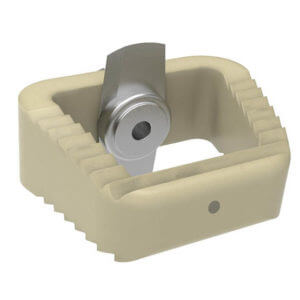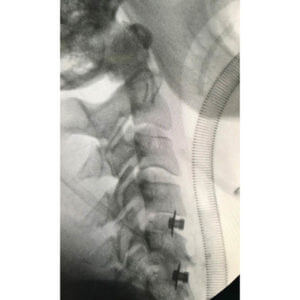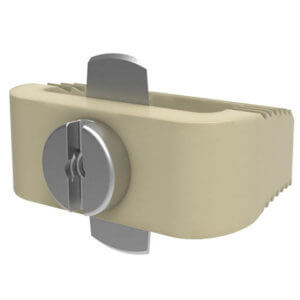An Anterior Cervical Discectomy and Fusion (ACDF) is performed through the front of the neck, generally to remove a degenerative or herniated disc that may be compressing spinal nerve roots or the spinal cord. This compression may result in neck, shoulder, upper back, and arm pain. Other neurologic symptoms may include numbness, tingling and weakness in the arms or hands. The aim of this surgery is to reduce pain by decompressing the nerve roots and spinal cord as well as stabilising the neck.
THE PROCEDURE
You will be given a general anaesthetic to put you to sleep. A breathing tube (endotracheal tube) will be inserted and you will be given a dose of antibiotics to help prevent infection. You will be placed on your back on the operating table. Calf compression devices will be attached to your legs, helping to minimise the risk of developing blood clots in your legs. An X-ray will be taken to identify and mark the level of the spine requiring surgery.
A small incision is made (2-2.5cm) on the right hand side of your neck, over the area of the spine to be treated. Generally the incision is made in a natural skin crease, which provides a better cosmetic result. The neck muscles are gently swept aside and a retractor is positioned to provide access to the spine. Microsurgical instruments are used to carefully remove the disc.Once the disc is removed, it is replaced with a cage, which is made of a very strong material (PEEK polymer). This cage has a cavity within it, and is packed with a bone substitute. This allows the bone above and below to grow through the cage, fusing the vertebrae together. A titanium fin on either end of the cage, secures it into the vertebrae above and below.We generally do not use anterior plates, as fusion rates do not require it. Further, plates may affect oesophageal function, leading to swallowing difficulties



Once the implant is in place, the retractor is withdrawn, and the skin is closed using absorbable sutures that do not need to be removed. A small dressing is applied.
RECOVERY
Patients are able to mobilise the same day as the surgery is performed, and often only stay in hospital overnight. It is common to have a sore throat and some mild discomfort with swallowing after the surgery. It is usual to feel some pain, especially at the incision site. This should decrease a little each day. You will be discharged with pain relief medications to manage this, and given a booklet outlining all postoperative instructions. Once at home you will receive a follow up phone call from the practice nurse. Postoperative appointments will be arranged for you at both the 2 and 6 week mark with the practice nurse and Dr winder respectively.
Once home, frequent short walks are recommended. This will help in your recovery and also reduces the risk of blood clots forming in your legs. A gradual increase in physical activity is advised.
You must not lift anything heavier than 5kg for the first 6 weeks post-operatively and avoid twisting and bending movements. Avoid housework such as vacuuming, mowing and hanging washing on the line for the first 6 weeks postoperatively.
Ensure you maintain correct posture when working in front of a computer. You will need to take frequent breaks, assitting for prolonged periods will cause your neck to stiffen and your posture to deteriorate.
You may drive 1 week after surgery if you are comfortable to do so but avoid long distances.
Physiotherapy is recommended 2 to 3 weeks after your surgery. Gentle stretches and postural control exercises will help to strengthen your neck after surgery.
Keep your wound dry, you will be given extra waterproof dressings on discharge. You may shower as normal but if your dressing becomes waterlogged it should be changed. Dr Winder’s practice nurse will check your wound at your 2 week postoperative appointment.
Dr Winder will discuss resuming sports and other physical activity at your 6 week appointment
Please note that it is not uncommon to have localised neck pain for up to 4-6 weeks. This will generally resolve spontaneously and is due to the sensitivity of the cervical musculature.
Depending on the degree of nerve compression, it is also very common to have some degree of arm discomfort, as it will take time for the compressed nerve to recover. Please do not be alarmed if you have some intermittent arm pain, as this is a normal part of the healing process.It is usual to feel some pain after surgery, especially at the incision site.
RISKS AND COMPLICATIONS
There are risks associated with any surgery, the most common being:
- Deep vein thrombosis (DVT)
- Urinary tract infection (UTI)
- Chest infection
- Pulmonary embolism (blood clot in lungs)
- Myocardial infarction (heart attack)
- Stroke
A full medical history including allergies, medical conditions and previous surgery is required before your surgery to help reduce the risk of complications occurring.
The main risks for ACDF surgery include:
- Damage to recurrent laryngeal nerve (0.025%), leading to a hoarse voice. If this occurs, it is almost always temporary.
- Vascular injury (very rare)
- Risk to spinal cord (elevated risk is 1/10,000)
- CSF leak
- Nerve root damage (very rare)
- Oesophageal perforation/ tracheal perforation (very rare)
If you require surgery, Dr Winder will discuss all relevant risks during your consultation.

